Brothers Nolan Experimental Coaxial Helicopter
ARTICLE DATE: April 1996
Herb and Jack have turned the kitting of their unique coaxial helicopter over to others.
Nolan Coaxial Helicopter – Consider this: Two brothers with obvious mechanical ability but no aviation experience decide to research the field and then design, build and learn to fly their own first-of-a-kind machine. After years of experimenting, they succeed, and they set out to profit from their success.
At this point, the similarity of the Nolan brothers of Jacksonville, Florida, and another pair of brothers involved in aviation pioneering breaks down. At least the Nolans could see how other I designers had solved the problem of hovering flight.
Nonetheless, I their start-from-scratch approach led to design and construction of a successful helicopter like none seen before: a twin-engine, coaxial-rotor,fixed-rotor-pitch machine that Jack Nolan (now 49) taught himself to fly in fairly short order.
After numerous attempts and some significant incidents, brother Herb, 59, decided to leave the flying to Jack, who demonstrated the Nolan 51-HJ single-seat prototype No. 3 at Sun ‘n Fun and Oshkosh last year.
Nolan Coaxial Helicopter: Before This
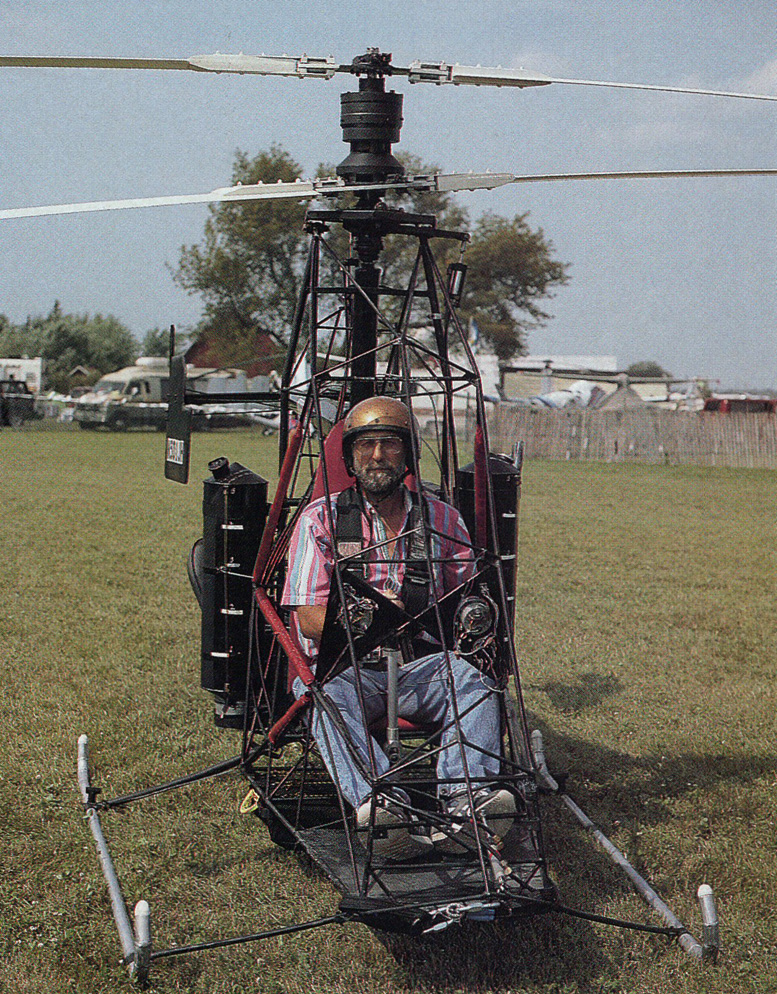
Jack prepares to launch again. Engines work independently through sprag clutches into the rotor mast. One engine provides enough power for an emergency run-on landing.
The Nolans have been flying their helicopter since February 2, 1994. Actually, it is their third such machine. They consider it to be their production prototype. The brothers had previously built racing cars and are of course mechanically disposed. Herb has also owned and operated a foundry and machine shop, and Jack was a foreman of a sheet metal facility.
Yet neither brother had been around aircraft before becoming involved with rotorcraft about six years ago. “Jack had always wanted to build an aircraft of some form since he was a young boy,” Herb says.
“Seeing helicopter histories and operations on TV proved to be a catalyst. We liked the idea of flying from confined areas, so we read up on helicopter designs. We were particularly drawn to the coaxial configuration since it eliminates the tail rotor that draws off engine power, requires additional components, and adds the possibility of having problems with them.”
The Nolans’ original helicopters were proof-of-concept vehicles that underwent various design changes during 30 hours of flying time. Major modifications included turning the engines from horizontal to vertical position, switching from a wet gearbox to a belt drive, and changing from pushrod controls to hydraulics.
Nolan Coaxial Helicopter: Unconventional Controls
The twin Rotax 503-powered 51-HJ that the Nolans brought to Oshkosh ’94 is called a coaxial pendulum helicopter. Its most unusual feature is that it has fixed-pitch rotors that preclude autorotations to a landing; there is no collective control to change main rotor pitch for direct control of lift.
Instead, altitude control is achieved by engine power alone. In effect the collective column has been replaced by two interlocking throttles—one for each individually operated engine. Jack sets one engine to a constant flight power and varies the output of the other engine to control altitude.
As the power controls were originally set up, a conventionally trained helicopter pilot could become confused because downward movement of the throttle levers in the 51-HJ increases power and climb, whereas raising the collective stick in other helicopters does this.
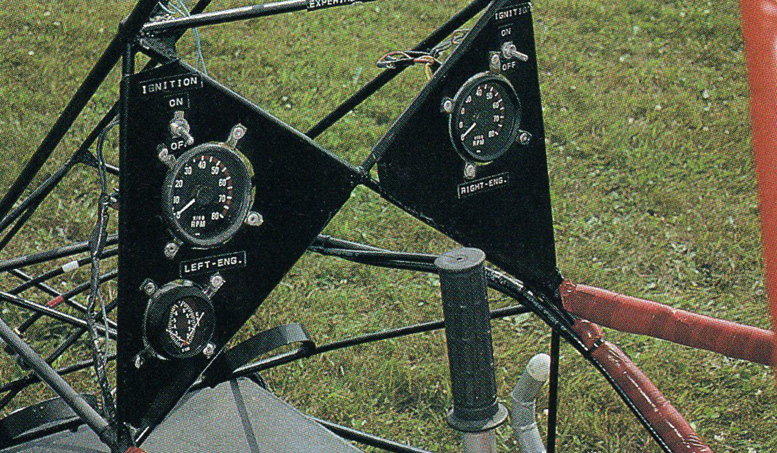
A bowtie-shape instrument panel provides the basics.
With one of its two 50-hp Rotax 503s failed, the 51-HJ Nolan Coaxial Helicopter does not have enough power to hover, but it can fly forward to a safe run-on landing.
A throttle tie-in device is fitted as a safety item to prevent the pilot from hitting the wrong throttle in case of an engine failure. No matter which throttle is grabbed, movement will include the working engine, resulting in additional power being obtained.
Under normal conditions, only 1 inch of throttle movement is needed to operate a single engine for maneuvering, and this is provided in the tie-in device. Cyclic—directional control—is accomplished through two hydraulically boosted constant velocity joints (gimbals) that tilt the entire twin-rotor, counter-rotating disc in the direction desired to fly.
Rudder pedals also actuate the unique twin tail surfaces. The large vertical forward sections of the tail provide yaw control during hover by angular motion in the down wash of the rotors, while the raised trailing portions serve as conventional rudders in forward flight. Tail surfaces are made of fiberglass and foam, each measuring 1 foot 8 inches high and 1 foot 9 inches chordwise.
Nolan Coaxial Helicopter: Getting It Flying
Development of the Nolan helicopter was a trial-and-error process from the beginning. “We followed to path of least resistance” Herb says, “and when we did not reach our goal, we tried another route.”
“Also, Jack and I can almost read each other’s minds, and since two brains are better than one, we always seem to come up with the best of ideas after discussing the situations.” The prototype airframe is a welded 4130 steel structure, the cockpit having a 2 foot 3.5-inch width at the shoulders.
However, kits will have a wider cockpit and a lengthened nose for additional leg room to accommodate taller and heavier pilots. The tailboom is 2024-T3 aluminum formed in a tapered hexagon configuration.
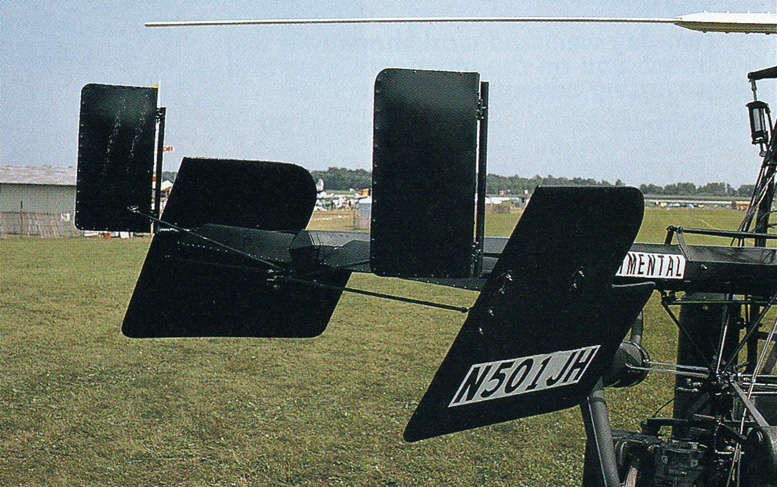
Yaw in hovering and forward flight is controlled by rudders that move on two axes.
Aluminum skids are strengthened by placing 2024-T3 tubes within 6061-T6 tubing. The gear is 7 feet 1 inch long and 5 feet 4 inches wide. The prototype has an empty weight of 481 pounds and a gross of 775 pounds.
The prototype has Nolan-built rotor blades of 16.5-foot diameter and 4-inch chord. The spars are on the leading edges and are half an inch thick. They extend back to 25% chord and were machined from solid extrusions to a NACA 0012 profile.
The rest of the blades are 2024-T3 skins that have been bonded and riveted to the spars and at the trailing edges. Vertical blade separation is 13 inches. Rotor rpm is said to be about 860 and blade tip speed 400 mph.
Nolan Coaxial Helicopter: Toward Safety
Because the 51-HJ cannot autorotate to a landing with a power failure, at least one of the two Rotax 503s must operate. Therefore the Nolans have built dual completely independent power packages, – each with its own 5-gallon fuel tank and 5-inch Poly-V belt drive through a sprag clutch to the single rotor shaft.
Each engine turns both sets of rotors. Only the rotor shaft and rotors are common to both power systems. The Nolans believe that—short of fuel contamination or wrong premix lubrication of the two-stroke engines—there is almost no chance of a double power failure.
Standard engine warmup and ground runup should minimize the chance of bad fuel causing both engines to fail in the air. But the remote possibility has led the brothers to consider a ballistically deployed parachute system as a last resort.
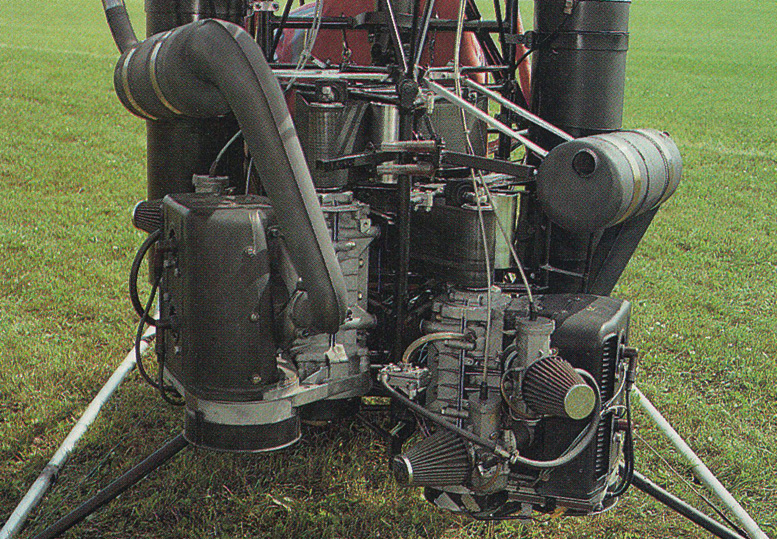
Two Rotax 503s mounted vertically provided power in the demonstrator. The Nolans now recommend a pair of more powerful Hirth engines.
After ground-deployed ‘chute firings, Herb and Jack hired a company to provide radio-controlled systems and an R/C pilot for airborne tests. However, equipment difficulties and pilot error resulted in two rotor-breaking crashes, and the chute tests have been put on hold.
Total 51-HJ Nolan Coaxial Helicopter flying time is now around 70 hours with flight in all regimes, but the envelope is still being expanded. Jack Nolan says he has flown the helicopter to 60 mph and anticipates that maximum level speed will be close to 75.
He has hovered in and out of ground effect and has taken the 51 -HJ up to 500 feet. “We have conducted many hours of hovering in ground effect to fine-tune the handling characteristics throughout this sensitive area of flight,” Jack confirmed.
Nolan Coaxial Helicopter: Marketing Update
The Nolans claim that their helicopter is a low-cost, durable vehicle of simple design with low maintenance and incorporating a crashworthy cockpit. It is said to be state of the art with integrated new technology.
Kits will sell for $17,995, less engines and avionics, but with the fuselage completely welded and major components fully assembled. The brothers anticipate that a kit buyer will be able to built the helicopter in 250 hours with only basic tools.
The first Nolan Coaxial Helicopter 51-HJ kit was sold to a Canadian without helicopter experience, and he taught himself to fly using the Nolan-recommended center-of-gravity tether system. Herb says. The pilot now has about 19 flight hours. Early this year, Herb confirmed some major changes. A pair of Hirth 2706 engines is now the recommended power.
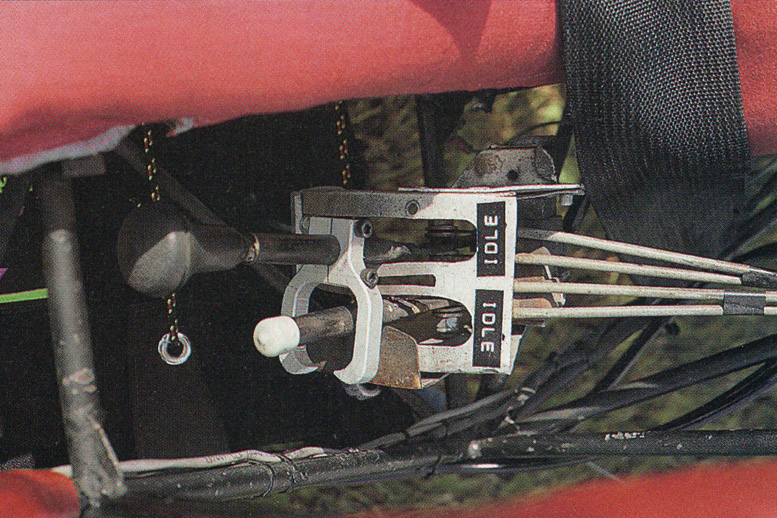
Lacking collective pitch, the 51-HJ is controlled vertically by changing rotor-system rpm with this throttle arrangement, which works backward from conventional helicopter power and collective controls.
Manufacturing and marketing rights for the Nolan Coaxial Helicopter have been sold to Eagles Perch, Inc. in Virginia. The company is expected to ship first kits by the time you read this and to produce a two-seat version that will be used initially for training. The Nolan brothers are involved in the design and construction of the two-seater.
The new company’s test pilot flew the Nolan Coaxial Helicopter (very carefully) with the unconventional power control setup, but the system has now been changed to operate like conventional helicopters. Flight demonstrations are expected in Chopper Town at Sun ‘n Fun, which runs for a week in Lakeland, Florida, beginning on April 14. If flight times are publicized, expect a crowd.
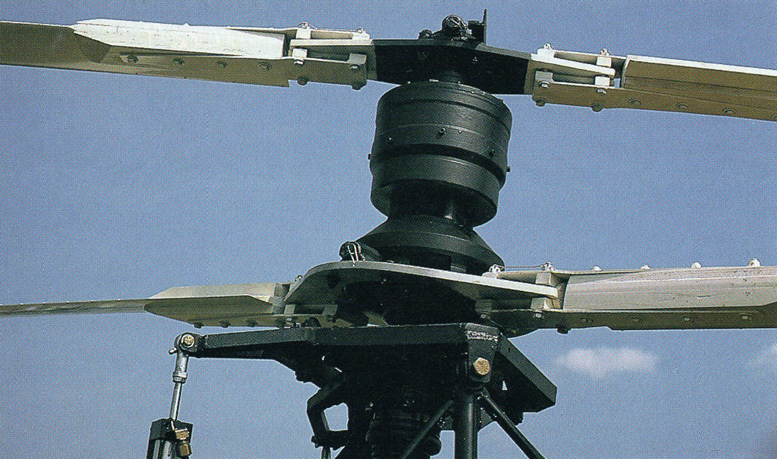
The cyclic stick operates hydraulic systems that tilt the two rotor discs for directional control.
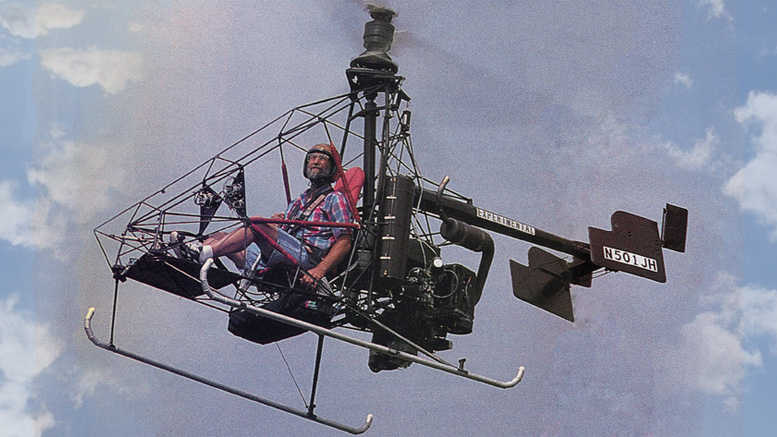


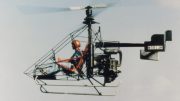
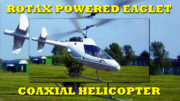
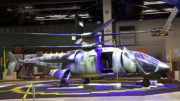
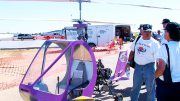
hello there,
I will like to know the price price ..
Thanks
Jean
My email contato@aviacaobr.com.br
If possible I need the price of the coaxial heli
A quick Google search found a few companies in Russia and one in Queensland, Australia. Search “coaxial helicopter” for more information.
Nice project…..
Hi,
can you please post pictures of the gearbox on the rotor?
Thank you,
Aleksandar